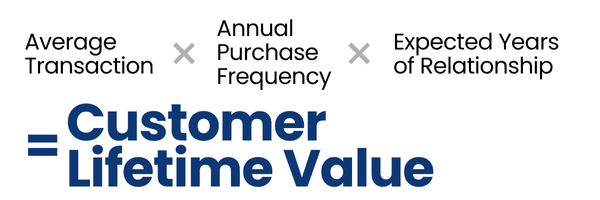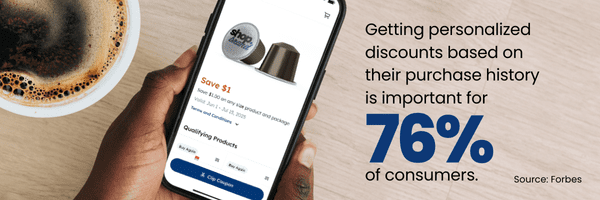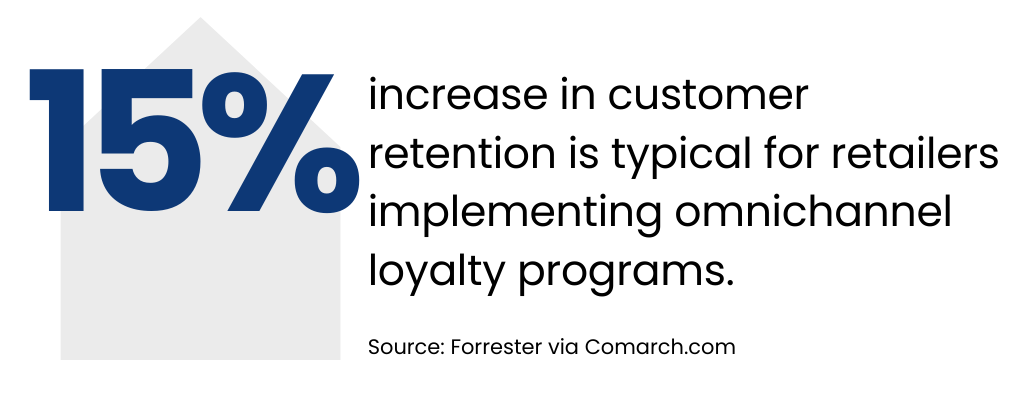
Why Customer Lifetime Value is the Most Important Metric in Grocery Retail Today
This article was originally published with the title “The health of your grocery business depends on customer lifetime value” on July 23, 2020. It was updated on April 2, 2024.
Short-term gains or long-term growth?
Businesses across every sector wrestle with these two goals, often pulling in opposite directions.
For grocers, one avenue for quick wins has traditionally come in the form of breakage—the quiet profits gained from unclaimed discounts, rewards, and promotions. The reasoning behind this is simple: When customers don’t redeem promotional offers, the grocer’s bottom line gets a hidden boost.
But as consumer expectations rise and technology advances, especially in online shopping, breakage is proving to be a short-sighted strategy that fails to build sustainable growth.
Instead, grocers are turning to more holistic measurements for customer relationships, like Customer Lifetime Value.
Why Does Customer Lifetime Value Matter?
As larger retailers like Walmart continue to take a larger share of the grocery market, grocers are seeing how important customer retention is to the total revenue of their businesses. This has resulted in Customer Lifetime Value becoming the most important KPI for grocers, because it prompts grocers to develop strategies focused on long-term relationships with loyal customers rather than quick wins.
In this article, we’ll explore how to measure Customer Lifetime Value and how grocers can use this metric to shape effective strategies. Specifically, we’ll look at how personalization—offering each customer a tailored online shopping experience—is capable of boosting Customer Lifetime Value.
Ultimately, this post will come to the conclusion that, to maximize Customer Lifetime Value, retail eCommerce must provide personalized shopping experiences that create the kind of loyalty and satisfaction that keep customers returning, again and again throughout the average customer lifespan.
The Customer Lifetime Value Formula
Traditionally, Customer Lifetime Value has been a mainstay in SaaS and other subscription-based eCommerce business types, where the lifetime value of a customer directly impacts profitability.
More recently, however, this metric has spread to retail, and in grocery retail, it’s emerging as especially important (for all the reasons mentioned above). Across industries and sectors, Customer Lifetime Value provides a powerful gauge for long-term financial health.

Calculating Customer Lifetime Value can be approached with varying degrees of complexity. In its simplest form, it’s measured as:
Average Order Value x Annual Purchase Frequency x Average Customer Lifespan = Customer Lifetime Value
This straightforward average Customer Lifetime Value formula provides a baseline measurement, but more complex models can include additional factors beyond average order value or average purchase value, like customer acquisition cost and retention rates, for a more refined view.
A Note About Average Customer Lifespan
When you calculate Customer Lifetime Value, it’s important to accurately estimate your average customer lifespan—the typical duration a customer stays active with your business.
This can be done in three steps:
1. Define Inactive Status
Determine when a customer is considered inactive, such as after 12 months without a purchase.
2. Track Lifespan
Measure the time between each customer’s first and last purchases to determine their individual lifespan.
3. Calculate the Average
Add up these individual lifespans and divide by the total number of customers to get the average customer lifespan.
The Power of Customer Lifetime Value
We began this article by talking about the tug of war between short-term gains and long-term growth that absorbs many businesses.
Customer Lifetime Value offers a unique solution to this struggle by measuring customer value over time, providing insight into both the current and future health of your business.
Like other KPIs, Customer Lifetime Value can serve as a baseline metric that grocers can remeasure over time, helping them gauge business performance and adjust strategies as needed.
This approach is gaining traction among retailers who have found that tracking Customer Lifetime Value improves customer retention, boosts sales, encourages brand loyalty, and enhances personalization efforts.
Customer Lifetime Value also complements other metrics grocers may already track, offering insights that go beyond what those metrics reveal on their own.
For example, it shares similarities with loyalty measurements, as both metrics consider the duration of the customer relationship. However, while loyalty metrics often overlook how much a customer actually spends, Customer Lifetime Value provides a fuller picture of financial health by combining both relationship length and purchase behavior.
Similarly, Customer Lifetime Value parallels return on investment (ROI) in that both measure customer actions, but the key difference lies in their scope. Customer Lifetime Value tracks spending patterns and behavior over the long term, while ROI typically captures the short-term impact of specific marketing tactics on total revenue.
By focusing on Customer Lifetime Value, grocers gain a broader perspective on customer impact, highlighting the value of nurturing relationships that span years rather than one-off purchases.
How Grocers Benefit from Measuring Customer Lifetime Value
And that’s important because few businesses are as long-term as grocery retail, which is what makes Customer Lifetime Value so important for this sector.
By activating strategies that encourage repeat customers to increase spend, buy more frequently and stay loyal for longer, you’ll boost the true average lifetime value of your shoppers and improve your bottom line over time.
Understanding and measuring Customer Lifetime Value also prompts grocers to craft strategies that prioritize their most profitable customers, ensuring marketing resources are dedicated to building relationships that drive profitability well into the future.
By identifying high-value customer segments, grocers can structure marketing and service efforts around those who drive the most profit over time, instead of scattering resources across all customers equally.
With Customer Lifetime Value insights, grocers can further prioritize tailored loyalty programs, targeted promotions, and customer service for their most valuable customers—encouraging higher average order value, increased average purchase frequency rate, and deeper brand loyalty.
In this sense, Customer Lifetime Value helps grocers reduce acquisition costs by focusing on the most profitable customers already shopping at your stores rather than new customers.
Using Engagement to Boost Customer Lifetime Value
But focusing on the most high-value customers doesn’t have to mean neglecting the rest.
Today’s engagement technology enables grocers to enhance the shopping experience for all customers while still prioritizing those who bring the most value. With engagement efforts driven by customer data, grocers can cost-effectively tailor experiences across segments, working to increase the lifetime value of every customer—all in the name of providing excellent customer service.
Here’s how digital engagement can help create a high Customer Lifetime Value by strengthening loyalty and encouraging greater spending across all customer segments:
Targeted Savings
Machine learning enables grocers to unify customer data and deliver individualized savings based on each shopper’s unique purchasing habits. By analyzing past purchases and browsing behavior, algorithms identify frequently bought products and time promotions to target customers accordingly.

For example, a customer who regularly purchases organic produce might receive a discount on organic vegetables just before their usual shopping trip. These targeted offers add convenience and reinforce loyalty by aligning directly with the shopper’s preferences, increasing customer satisfaction through a seamless and rewarding experience.
Customizable Customer Loyalty Programs
Loyalty programs can also adapt to individual preferences and behaviors, offering greater value than traditional one-size-fits-all programs or nominal and basic rewards. With dynamic, data-driven loyalty programs, grocers can provide personalized incentives based on shopping patterns, ensuring more relevant and easy-to-redeem offers.

For instance, high-frequency shoppers might earn exclusive discounts tailored to their purchase history, while occasional shoppers receive incentives encouraging them to visit more often. Personalized loyalty rewards like this can be used to enhance engagement across multiple segments, keeping individual customers returning and driving greater spending by maintaining program relevance to each shopper’s habits.
Predictive Personalization
What really ties everything together is the capability to align these features with purchase cycle.
Predictive personalization leverages advanced algorithms and machine learning to anticipate and meet customers’ future needs, creating a convenient and habit-forming shopping experience. By analyzing purchase cycles, personalization tools can automatically deliver timely offers just before the customer’s next likely visit.

For customers who restock on certain pantry staples every few weeks, predictive technology could send a curated shopping list or targeted discounts right when they’re due to shop again. This makes shopping easier for loyal customers by anticipating their needs, encouraging frequent visits, a higher average order value and ultimately increased Customer Lifetime Value.
By implementing this type of technology, grocers can effectively increase Customer Lifetime Value across all segments. This approach not only focuses on high-value shoppers but also enhances the experience for every customer, building loyalty and retention across segments in a cost-effective way — an essential strategy for grocery businesses, as Customer Lifetime Value reveals.
Mercatus Offers The Technology Grocers Need To Boost Customer Lifetime Value
The personalization described above — from targeted savings to predictive, loyalty-driven experiences — is precisely what Mercatus’s customer engagement solutions deliver.
Designed specifically for grocery retailers, Mercatus provides an advanced, cost-effective platform that empowers grocers to take full control over their customer interactions, creating personalized, data-driven experiences that drive Customer Lifetime Value.
Our customer engagement technology combines first-party data and sophisticated algorithms to optimize the customer journey. By consolidating customer insights from digital and in-store interactions, Mercatus helps grocers deliver value, convenience, and relevance at every touchpoint while managing operational costs efficiently.
The result is:
Data-Driven Engagement
Mercatus uses comprehensive first-party data to provide personalized recommendations, promotions, and loyalty offers, allowing grocers to reach customers with the right message at the right time.
Increased Customer Lifetime Value
By activating targeted campaigns — from personalized product suggestions to timely promotions and loyalty incentives — grocers using Mercatus’s solutions report higher average order values, improved customer retention, and substantial returns on their digital engagement investments.
Scalable Engagement
With no complex coding required, Mercatus’s solution integrates seamlessly into existing systems, allowing grocers to scale engagement efforts efficiently and achieve measurable results without added operational burden.
Grocers who implement Mercatus’s platform have seen significant gains in monthly active users, increases in average order value, and stronger customer loyalty. With proven ROI and integration ease, Mercatus offers the engagement solution that grocery businesses need to compete—in both the short- and long-term—with the increasing market share being taken by larger retailers.
To learn how Mercatus can help your business meet the demands of modern consumers and boost the value of existing customers, reach out to our sales team today.
 Newsroom
Newsroom
